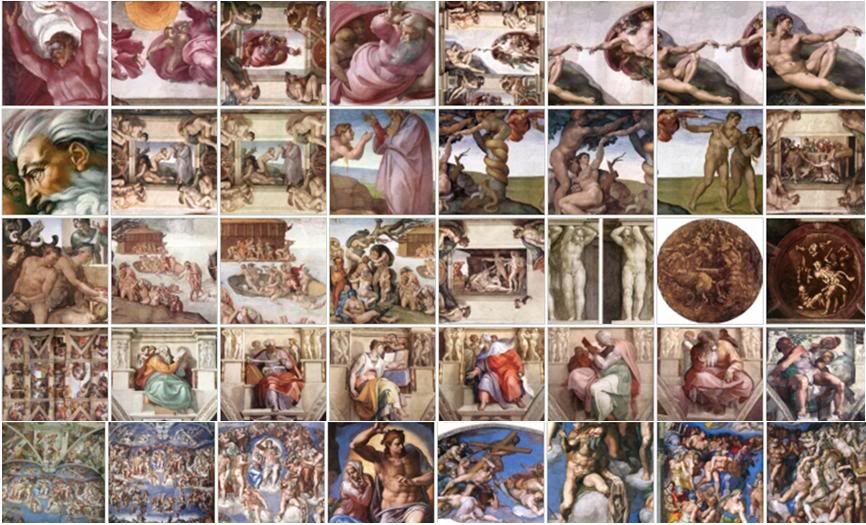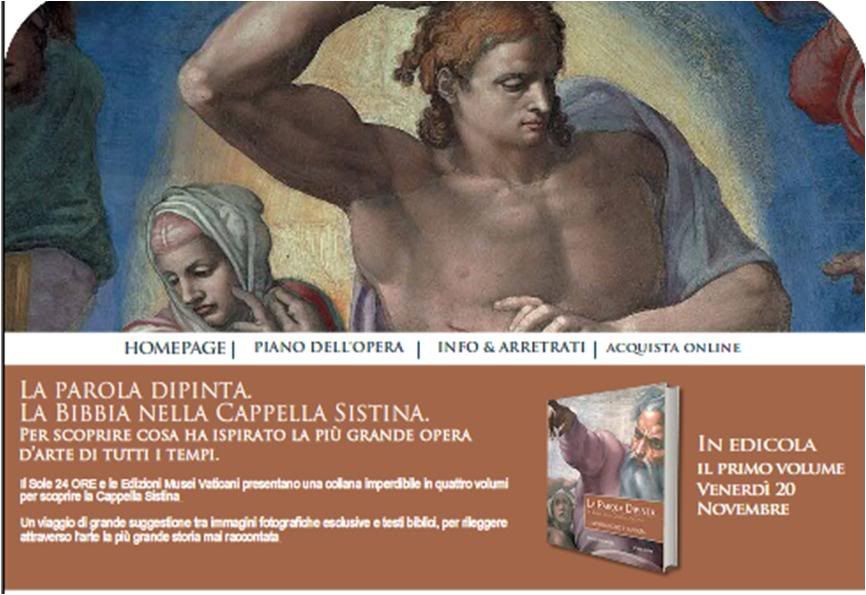 Books presented at the Vatican
Books presented at the Vatican
look at how the Bible is depicted
in the Sistine Chapel

 LA PAROLA DIPINTA: La Bibbia nella Cappella Sistina, vol. 1-4, Vatican Museums & Il Sole 24 Ore, 2009.
LA PAROLA DIPINTA: La Bibbia nella Cappella Sistina, vol. 1-4, Vatican Museums & Il Sole 24 Ore, 2009.
VATICAN CITY, Nov. 17 (AP) - A series of four books presented Tuesday at the Vatican seeks to explain how Michelangelo and other artists translated the Bible into images to produce in the Sistine Chapel some of the world's most renowned frescoes.
The first volume focuses on Michelangelo's ceiling and its scenes from the book of Genesis and the creation of the world. Vatican Museums director Antonio Paolucci said the volume offers a "basic code" to understand the symbols and scenes that adorn the room where popes are elected.
"Everybody knows the Sistine Chapel, but how many can recognize the scenes?" Paolucci said Tuesday at a book launch just steps away from the Sistine Chapel.
He said the book succeeds in clarifying "the infinite forest of symbols that are all linked to each other" in the ceiling that the Renaissance master painted between 1508-12.
The series is called LA PAROLA DIPINTA (The Painted Word) and is published by the Vatican Museums' publisher along with Italian daily
Il Sole 24 Ore.
The first installment, a coffee-table volume rich in photos, comes out on Friday. Two more will follow focusing on the wall paintings by 15th-century artists such as Sandro Botticelli, and the series will end Dec. 11 with a volume on Michelangelo's Last Judgment.
The Sistine Chapel is part of the Vatican Museums, which gather hundreds of artworks from painters including Raphael, Titian and Caravaggio. Over 4 million people visit the Vatican Museums every year.
CNS has a more detailed story:
Sistine Scriptures: New book series
underlines Bible stories behind the art
By Cindy Wooden


VATICAN CITY, Nov. 18 (CNS) -- To really see the Sistine Chapel, it's more important to have a Bible in your hands than mini-binoculars, said Msgr. Roberto Zagnoli, an official of the Vatican Museums.
The Italian monsignor is the principal author of "The Painted Word," a new series of books published by the Vatican Museums and the Italian financial newspaper
Il Sole 24 Ore.
In the four-part series, the Italian monsignor quotes and explains the biblical passages that inspired the famous frescoes in the Sistine Chapel. The first volume focuses on Michelangelo's work on the Sistine ceiling.
"Fascinating the eyes and the spirit," visiting the Sistine Chapel with a Bible helps visitors appreciate Michelangelo's work and come to a more vivid understanding of the Scriptures, said Cardinal Giovanni Lajolo, president of the commission governing Vatican City State.
The cardinal presented the first volume of the new series Nov. 17 in the Vatican Museums, which plans to issue the series in English in December.
The ceiling frescoes Michelangelo painted from 1508-1512 focus on nine events from the Book of Genesis; the artist's depiction of the creation of Adam -- with God's outstretched hand filling him with life -- is one of his most widely recognized works.
Msgr. Zagnoli said that rather than showing God shaping Adam out of the clay of the earth, Michelangelo "presents Adam as coming forth from the earth, called to life by the powerful hand of God."
The artist's choice, he said, underlines the mysterious and forceful creative power of God.
In the scene of the creation of Eve, she is shown with her hands clasped in prayer or thanksgiving with her mouth partially open, "underlining the awe and marvel of that first instant of life," the monsignor wrote.
Antonio Paolucci, director of the Vatican Museums, said everyone knows of Michelangelo's solitary and even misanthropic character, but too many fail to recognize the religious passion he brought to the work.
"The entire Sistine Chapel, taken as a whole, tells the history of salvation," he said. But in order to understand that people need to read the Bible, Paolucci said.
The themes treated in Genesis -- the origin of the universe, the uniqueness of each human person, the presence of good and evil in the world -- "are matters of faith for us Catholics, but they also are issues of common concern for all human beings," which is why each of the millions of people who visit the chapel every year can be touched by the experience, he said.
"The hope is that those who read the book will feel led to approach the word of God and discover unexpected riches there and that they will allow themselves to be excited by the language of beauty," which is a reflection of the beauty of God, Paolucci said.
 From the webpage cappella-sistina.ilsole24ore.com/ dedicated to the book series.
From the webpage cappella-sistina.ilsole24ore.com/ dedicated to the book series.
Pier Luigi Vercesi, director of
Il Sole 24 Ore's publishing group, said that as an executive in a company primarily concerned with business and finance, he felt an obligation to figure out how much it cost the popes to build and decorate the Sistine Chapel.
He said the chapel cost "3,000 ducat," a monetary unit that no longer exists. But a rough calculation of the purchasing power of 3,000 ducat today would be between 1.5 million and 2 million euros ($2.2 million-$3 million), he said, "which means that the Sistine cost 1,200 euros a square meter ($167 a square foot)."
The newspaper is releasing the Sistine Chapel volumes every Friday Nov. 20-Dec. 11. The second and third volumes look at the work of the 15th-century painters, including Sandro Botticelli and Perugino, who depicted events from the life of Moses on the chapel's south wall and events in the life of Christ on the north wall. The final volume returns to Michelangelo, examining the Scriptural basis of his massive fresco of the Last Judgment.
New look for Holy Cross reliquary
in the Vatican collection
By NICOLE WINFIELD

VATICAN CITY, Nov. 19 (AP) – One of the gems of the Vatican's priceless religious art collection — a 6th century reliquary containing the purported fragments of the cross on which Jesus was crucified — has been restored to its Byzantine-era glory.

The Vatican on Thursday unveiled the restored Crux Vaticana, a foot-high (40-centimeter-high) jewel-encrusted golden cross containing what tradition holds are shards of Jesus' cross inside.
The Associated Press was given an early look at the piece, and Byzantine art experts said the restoration rendered the cross much closer to what it would have looked like at the time the Byzantine Emperor Justin II gave it to the people of Rome.
Most significantly, the restoration corrected a botched 19th century restoration that threatened to corrode the piece. And it replaced the brightly colored gems that were added in previous centuries with the large, imperfect pearls that are emblematic of Byzantine-era imperial masterpieces, said restorer Sante Guido.
A circle of 12 pearls now surrounds the relic, and pearls around the cross' edge now alternate with emeralds and sapphires — the two other gems most often associated with Byzantine emperors, he said.
While there are purported fragments of Christ's cross in churches around the world — including at Paris' Notre Dame and even across town at Rome's Holy Cross basilica — the Crux Vaticana is considered the oldest reliquary of the cross. It is the crown in the Vatican's Treasury of St. Peter's collection of religious and historic artifacts.
In addition to the relic inside, the cross itself is an important piece of early Christian art. Measuring 40 cm by 31 cm (15.75 inches by 11.81 inches) it's a rare example of an imperial gift and an expression of the emperor's Christian faith.
Across the piece is written in Latin: "With the wood with which Christ conquered man's enemy, Justin gives his help to Rome and his wife offers the ornamentation."
"It's the most important reliquary of the 'true cross' that we have," Guido told the AP. "It's particularly important because it's the only reliquary that came from an emperor, so there are various levels of religious and historic significance."
For centuries, the cross was used in the Vatican's most solemn ceremonies at Christmas and Easter. But 1,500 years of candle wax and smoke had dulled the gems and the cross's warm golden hue — grime that has been removed following a two-year restoration.
The work was paid for by an anonymous donor who didn't want the pricetag to be made public, officials said.
Ioli Kalavrezou, a Byzantine art history professor at Harvard University who has taught classes on the cross, said the restoration clearly rendered the cross closer to what it would have looked like when it was presented to Romans sometime between 565-578.
"I can't say it's exactly as it would've been, but it comes much closer to what an object like that would've looked like," she said in a phone interview.
The exact circumstances of why Justin gave Rome the relic are unclear. Guido noted that even though the eastern Byzantine Empire gained prominence in Constantinople after the 476 fall of the Roman Empire, Rome remained a religious capital because it was the "city of martyrs" — where Saints Peter and Paul were buried.
Emperor Justin clearly wanted to give the Pope and people of Rome "a recognition of Rome as a city of Christianity," Guido said. At the time, most parts of Christ's cross were in the hands of the Byzantine emperor in Constantinople after being moved from Jerusalem in the 4th century, Kalavrezou noted.
"This is one of the earliest examples of this imperial gift, where he (Justin) shows the power he has in his hands — to control the most important relic in Christiandom and to have the luxury to make a gift of that," she said from Washington, where she is a visiting scholar at the Dumbarton Oaks Byzantine research library.
The cross will be on public display inside St. Peter's Basilica through April 12.
The 11/20/09 issue of L'Osservatore Romano has this item about the Crux Vaticana:
The emperor's gift
Translated from
the 11/20/09 issue of

The exposition 'Vexillum Regis: the Crux Vaticana, or Justin's Cross" opened Thursday, Nov. 19, at the Sacristy Chapel of St. Peter's Basilica.
Until April 12, 2010, one can admire the jeweled cross, recently restored by Sante Guido who restored it after the super-impositions and damages undergone by the original over the centuries.
Characterized by a precious adornment of pearls and gems, the jeweled cross also carries the inscription: "Ligno quo Christus humanum subdidit hostem dat Romae Iustinus opem et socia decorem ("With this wood, through which Christ subjugated the enemy of man, Justin presents Rome with the work and from his wife, its ornaments") in characters typical of Latin writing at the end of late antiquity in the Oriental part of the empire.
The text manifests the votive intention of the emperor: to donate to the city of Rome a treasure that is an exemplary testimony to the faith, and from, his wife, the Empress Sofia, the pearls and gemstones that she endowed on it for the same purpose.
In the present restoration, the crown of twelve pearls around the sacred relic of the Cross has been put back, along with the 18 pearls along the front edge of the outer framework.
In the 18th century, the precious stones decorating the cross had been replaced with semi-precious gems, just one indication of the improper handling of the reliquary which lost much of its original design as it had been conceived by the imperial goldsmith in Constantinople.
After the Cross reliquary was restored, it was also decided to create a new compartment for the relic, following the description in the 1779 treatise
De Cruce Vaticana by Cardinal Stefano Borgia, which reproduced both the front and back designs of the Cross.
[Modificato da TERESA BENEDETTA 20/11/2009 06:08]